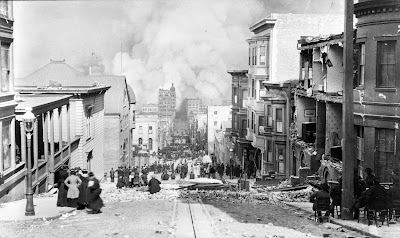I know disasters. In ten years as an author, I have written about no fewer than seven, including floods, fires, and storms.
In The Fire and The Memory Tree, I burned a few characters in the Great Fire (1910) and Cloquet Fire (1918). In September Sky and Indiana Belle, I blew them away in the Galveston Hurricane (1900) and Tri-State Tornado (1925). I doused thousands in River Rising and Hannah's Moon, which featured the Johnstown Flood (1889) and the sinking of the USS Indianapolis (1945). In The Journey, I pushed my protagonist in the path of Mount St. Helens (1980).
I hope to be kinder in the The Fountain, my current work in progress, but I'm not sure I'll be able to. I may not be able to work around one of the most destructive earthquakes in United States history.
On April 18, 1906, nature didn't just throw a fit. It shook San Francisco to its core. It reduced a city of 400,000 people to rubble and lit the match of an even more horrific fire, a fire that changed the world.
The quake itself was bad enough. Estimated at 7.9 on the Richter scale, it rocked most of California and created a rupture three hundred miles long. In some places, it displaced the earth by twenty-eight feet.
The fires did the rest. For four days, they burned mostly uncontrolled, destroying 28,000 buildings, killing up to 3,000 people, and leaving half of San Francisco homeless. They altered the face of a beauty.
Bad luck made things worse. The quake mortally wounded San Francisco's capable fire chief. Authorities who tried to create firebreaks with dynamite created tinder instead. A woman cooking breakfast for her family sparked the 'Ham and Eggs' fire, the worst of dozens that swept the city. Fractured pipes rendered water resources useless.
Hundreds recorded the disaster in words and images. The Call, the Examiner, and the Chronicle, rival newspapers, joined forces for a special edition. Photograher Arnold Genthe began snapping pictures, including the one of Sacramento Street above. Novelist Jack London, who plays a cameo role in The Fountain, rushed to San Francisco from his nearby ranch to capture the essense of the tragedy.
Many residents rushed to get out of the city. Those who remained battled water shortages, disease, violent crime, blackouts, and martial law. The Army, which patrolled the streets until civilian authorities could restore order, shot even suspected looters and conscripted the able-bodied to fight fires and dig graves. Some buried bodies where they fell, mere minutes ahead of the rats and the flames. Others flocked to tent cities and relief centers. Most did what they could do to survive.
Like the disasters in The Fire, September Sky, and River Rising, the quake will dominate the last quarter of its story. Like the other calamities, it will display good behavior and bad in sharp relief.
I have completed a third of The Fountain's first draft. I hope to publish the novel, the first in the Second Chance series, by Labor Day.
